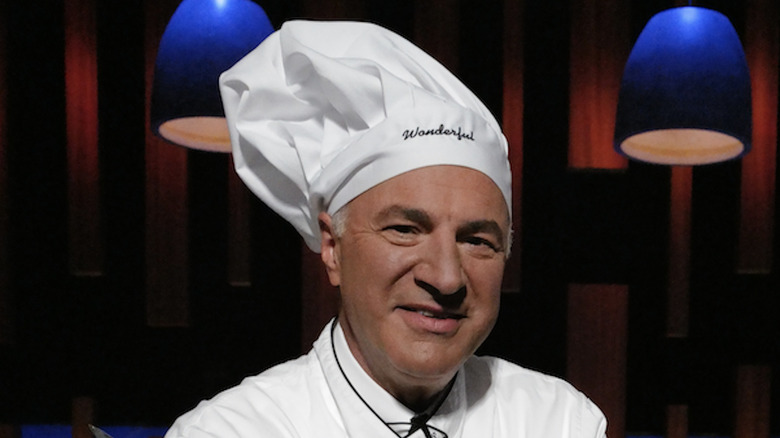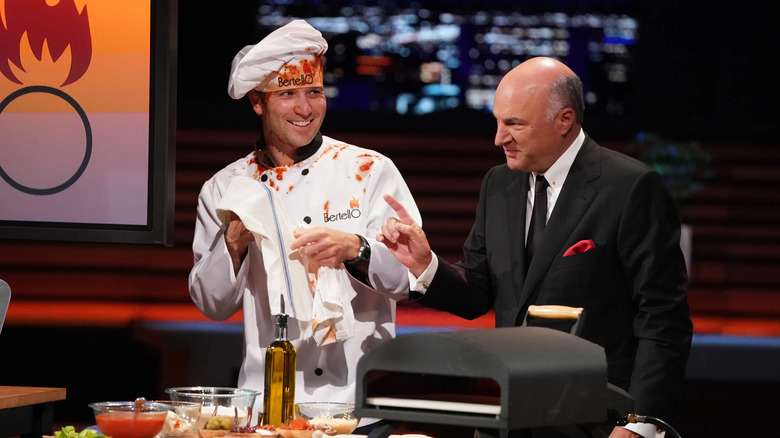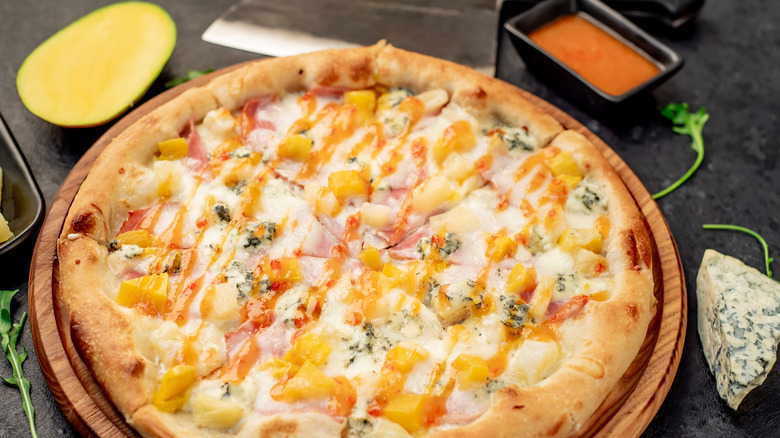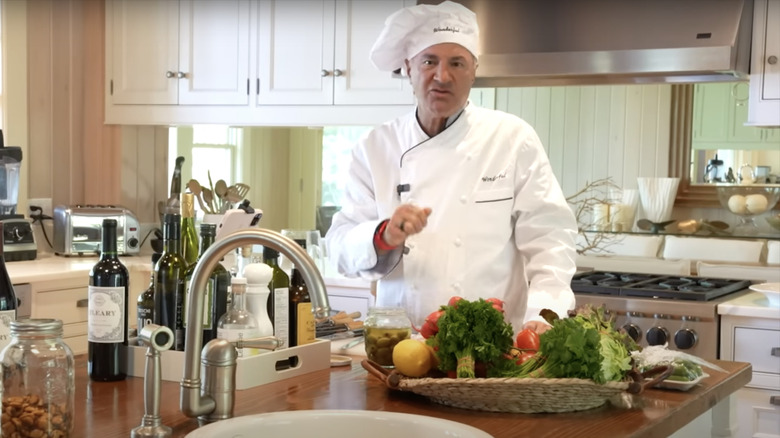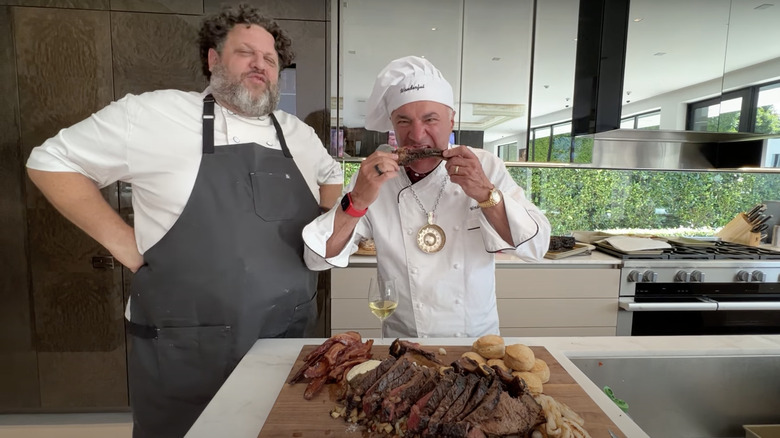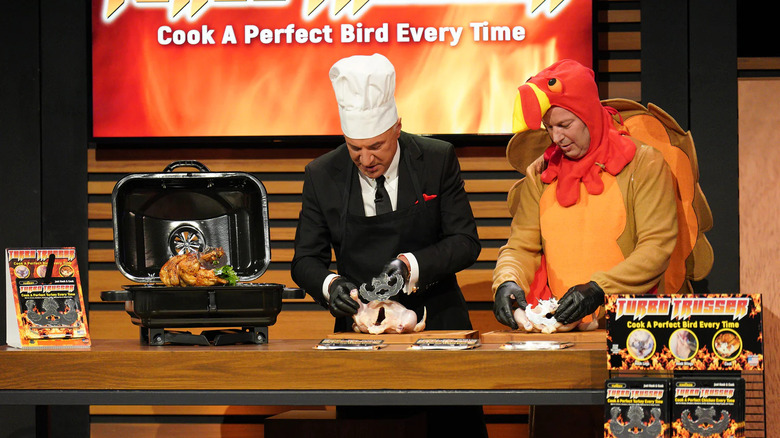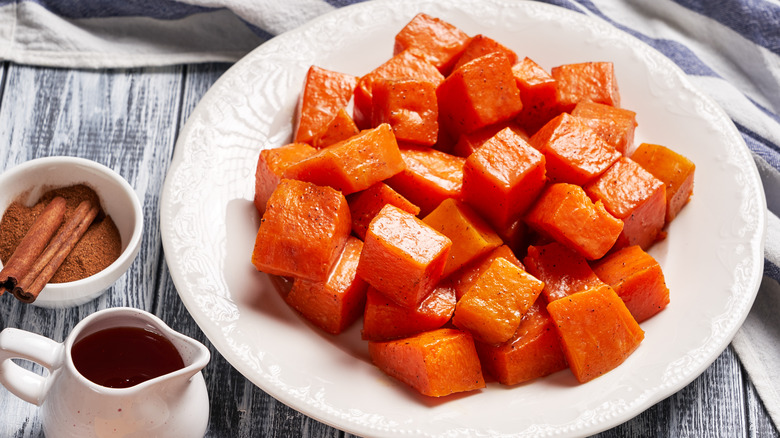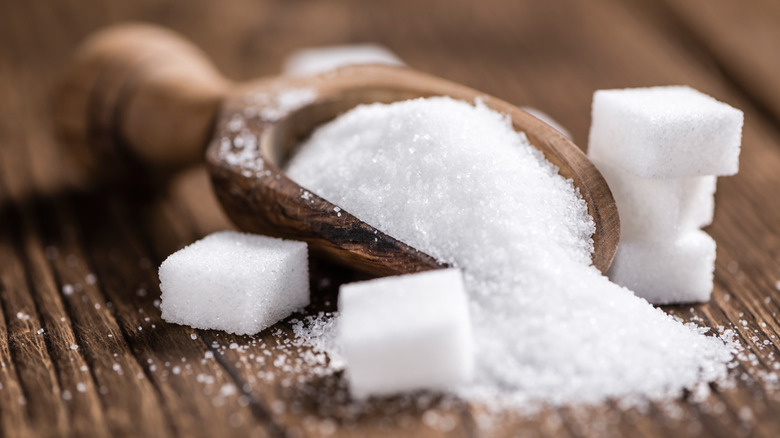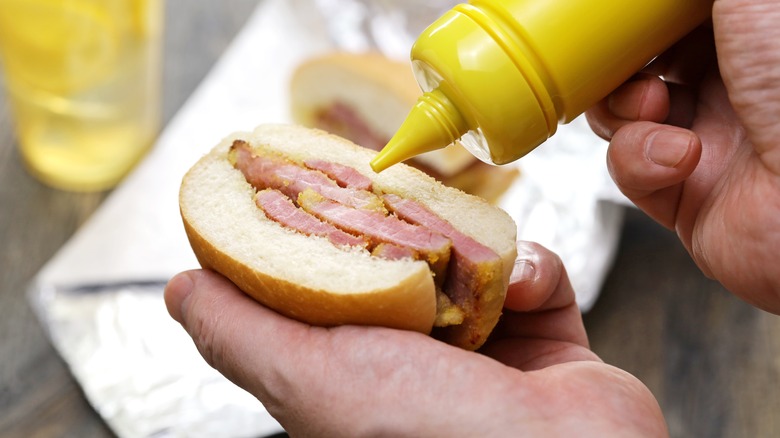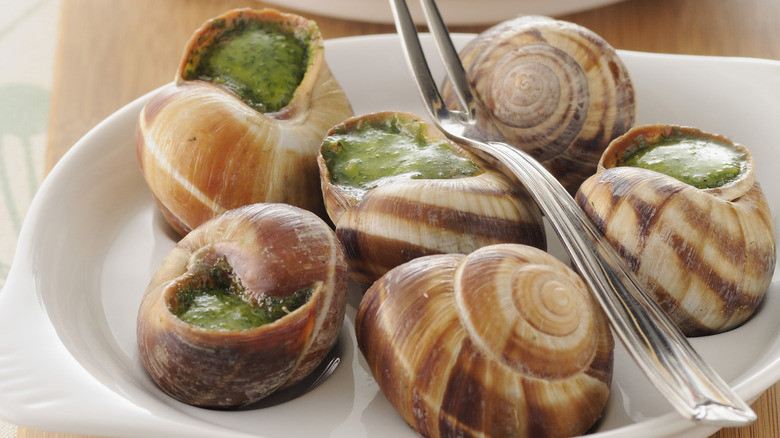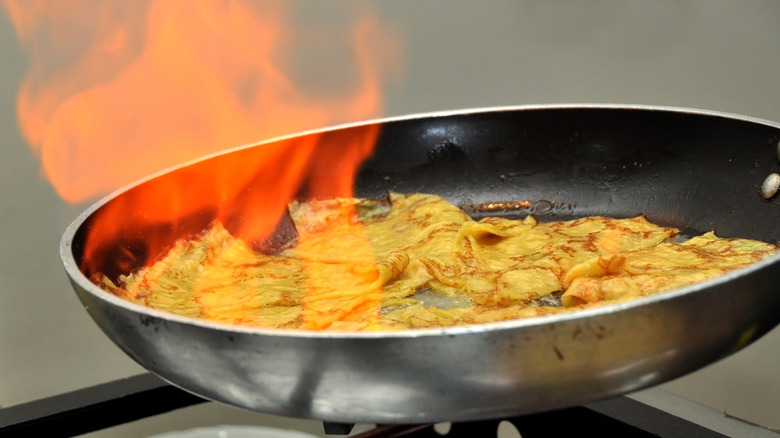Shark Tank's Kevin O'Leary Shares His Home-Cooking Secrets - Exclusive Interview
We may receive a commission on purchases made from links.
You probably know Kevin O'Leary, AKA Mr. Wonderful, best from his time on "Shark Tank" (and its Canadian predecessor, "Dragon's Den"), where he has been judging hopeful entrepreneurs and their products for almost two decades. If you're a huge fan, you might be aware that O'Leary made his first fortune from the software company SoftKey. You might be surprised to find out that he also likes to call himself "Chef Wonderful" and that he's an avid and skillful home cook. His enthusiasm for food has led him to invest in "Shark Tank" products like Bertello pizza ovens and the Turbo Trusser, and you can also find him doing cooking demonstrations on YouTube.
We spoke with O'Leary in an exclusive interview, where the Shark talked about his secret cooking tricks for a diverse array of dishes, including pizza, roasted birds, filet mignon, and even escargot. Ever the salesman, he also talked about why everybody needs the "Shark Tank" products he has invested in.
Why Kevin O'Leary loves Bertello pizza ovens
I recently talked to Eric from Bertello. What about his pitch made you want to invest?
What really attracted me about the product was the very attractive price and the combination of gas and wood, which is unique in terms of price point. You find that feature, but at much higher prices. That mattered to me a lot, because I'm a big fan of being able to have the option of value. I use that product a lot. I find them so easy to work with, and it's been a wildly successful "Shark Tank" product, that's for sure.
What advice do you have for people who are looking to nail their at-home pizza recipe?
I consider myself a bit of a pizza expert, believe it or not. People think they can buy a stone and stick it in the oven, heat it up, and then cook your pie that way. The reason that never works is you need that intensity of heat. The classic pizza oven gets up to 800 or 900 degrees, and you're not going to do that in the home oven. You almost want to flash cook a pizza, so that the crust dries and gets crispy on the bottom, but the cheese melts, and the toppings blend their flavors. There's no way to do that without a classic pizza oven. Whether you go with gas or wood fire, that's how you've got to do it. Frankly, if you taste the difference once, you never go back.
The origin of mango sauce on pizza
What are your favorite pizza toppings or style of pizza?
People overdose their pizza. They put way too much in terms of toppings. Whatever you think you're putting on there, you should cut it down by half, particularly on the tomato sauce. You don't need that much to make the pizza flavorful. When you go to Napoli or any of the places in Italy where the classic pizzas are made, it's a hint of tomato sauce, it's a hint of mozzarella. That's how the crispiness, the intensity, and the flavors come.
I go to all kinds of different toppings. I love green olives. I love different meat; sausage for example. I have done everything, even turkey and chicken. Hawaiian, I'm all over it. I even do mango sauce on it. You name it. You can go anywhere when you're making your own pie. The other trick: cool it on the sugar. Don't put extra sugar in the dough. Don't put extra sugar in the tomato sauce. That's unnecessary. It kills the flavor. It softens the acidity of the tomato sauce. Basil's fantastic. I could go on for hours. That's the whole joy of making pizza — the experimentation like this.
I'm curious about the mango sauce you mentioned. Is it like a mango chutney that you're putting on pizza?
Let me explain where I'm coming from on that one. When I was growing up, one of the places I lived in, because my dad was with the United Nations, was Phnom Penh, Cambodia. We had two chefs, because we were ex-pats and living in Cambodia. They were traditionally a French colony, but the traditional French dishes, like escargot or crepe flambe, could not be made with traditional cream. They would be rancid by the afternoon when you served them because it was so hot there.
They had to experiment with things like lime juice, papaya juice, mango chutney, and mango paste. You can get flavor without having an element that's going to go rancid from dairy.
How Mr. Wonderful cooks at home
How do you choose the recipes you film? It's a wide range of cuisines I've noticed on your cooking YouTube stuff.
It just happens. I film what I'm making for a party or guests or something, and everybody has different tastes depending on the time of the year. Turkey time comes at Thanksgiving. In the summertime, people love souvlaki, because you can make it on the spot. I have the little skewers in the fridge ready to go if guests come over. It is based on my own needs and the experience of the guests. I do a lot of cooking. I cook for my family almost every day, and it's whatever is on their mind and wherever we want to go. I'm prepared to go to Lebanese food, Irish food, North American, Italian, Swiss, French, whatever. I always add my own signature to it.
What's your favorite Lebanese dish to eat or cook?
Kibbeh, which is a ground meat dish, either made with lamb or beef. It's a classic dish. Lebanese food is a tremendous amount of work to prepare. Every dish is a labor of love. It can't be made quickly. It's impossible. My grandmother was Lebanese. When I was growing up — I'm half Irish, half Lebanese — she would mandate a 5:00 dinner on Sundays for the entire family. She and her daughters would start preparing at 11 in the morning, and they'd work all day.
If you didn't show up for that dinner, you burned in hell in perpetuity. You'd have to be either sick or dead not to show up. That, I learned, was very much a Lebanese tradition that bonds families together. I learned to cook all these dishes from her. I would caution anybody that thinks they can whip together a Lebanese dish: it is a brutal amount of time involved, and you can't miss any steps, or people who know those flavors are going to nail you when they taste it.
Tailgating food favorites
I noticed you posted a tailgating food video recently, too. What's your favorite thing to eat while you're watching the game?
I go for the classics: ribs, wings, multiple types of ribs and different sauces. Some like it spicy, and some like it sweet and sour. Pizza is in there, no question about that. With tailgating, because you're watching multiple games on a Sunday, it comes in waves. I'll end the whole night on the Sunday night game with a hip of beef. I'm carving, at that point, on a bun with horseradish. Those get devoured, even though people have been eating all the other stuff all day. You've got to have a salad, usually a pasta salad, in there.
You want a lot of diversity. Sometimes, I'll do meatballs, but I've never had anybody say to me, "There's too many options." Tailgating is like, "Lay it all out there." If you don't have the time to do it, you can order this stuff in, but it's never as good. I like to make it that day.
I've even done a turkey at tailgating, which is a bit of a surprise to people. You can cook turkey legs like the big brontosaurus-sized legs, and you'd be surprised how many people are willing to eat that at a tailgating party. They'll chow it down.
The genius of the Turbo Trusser
Speaking of turkey, I rewatched the clip of you negotiating with the team behind the Turbo Trusser on "Shark Tank." What was your thought process surrounding that deal?
You want products on "Shark Tank" that are easy to demonstrate on television. That's part of what makes it successful. You've got this great product that solves a problem in a very simple way and is low-cost. I'd already known, long before I met these guys, the challenges of trussing a bird, because everybody thinks tying up the legs is all you have to do. That's not where the juices are lost. On a turkey or a chicken or even a Cornish hen, when you crank up that oven and you're starting to cook it and you've got baker's twine maybe around the legs, after about 20 minutes, the string that's tied the wings up burns off. It always burns off.
The wings expand out, and the crevice between where the wing is attached to the breast, that's where the loss occurs. You lose two thirds of the juice, unless you figure out a way to truss it so the wings are compressed to the meat mass, and the only way to do that is with something that's not going to burn off. That's what the Turbo Trusser does so well. It's metal. It doesn't burn off.
You're a very active participant in the marketing of all the products you get involved with.
Yeah, that's what's great about "Shark Tank." The Sharks have millions of followers. Once we're an investor in the company, we want to tell the story of the product and service. We want everybody to know about it. I don't invest in products I don't use. I've got to use it, personally, if I'm going to invest in it. I use the Turbo Trusser probably twice a week now on every chicken I cook, and my birds are so spectacular. I'll let you in a little secret — we're bringing out one for Cornish hens just for me.
Thanksgiving in the O'Leary household
People are going to be using the Turbo Trusser a lot at Thanksgiving. Does your family have any unique Thanksgiving food traditions?
I make the turkey, but what I do is a very simple baste. I take a little bit of garlic, a little bit of olive oil, a lot of lemon, some za'atar spice, some pepper, and a tiny bit of salt. I make a mesh. I make a rub out of that, and I put it underneath the skin and on the skin itself. I stuff the bird with slices of white onion and slices of lemon. I truss it and I cook it. It's such a simple way to prepare, but it's so flavorful.
People freak out when they taste it. They say, "How'd you do this?" The secret is the za'atar, a spice that's ancient. It's a Middle Eastern Lebanese spice. It's roasted sesame seeds, crushed. That's the secret. It tastes spectacular on a bird that's been roasted. There's nothing like it.
It's my most used spice. It's very healthy, very low-cal, but incredibly flavorful. I put it on salads. If I make a salad of just olive oil and lemon and za'atar, people say, "What is this dressing?" It's the za'atar. That's the secret. If you're talking about anything [after] our conversation today, make it about za'atar, because that is the secret to so much of what I do.
Do you have any favorite Thanksgiving sides?
It's usually a squash. People want that. I generally do all kinds of color on the sides — a sweet potato, a squash, string beans, and broccolini. It is whatever I find fresh that day, and it's very simple. I steam it, and then I put a little olive oil on it, a little lemon, and a little sprinkle of za'atar on everything. You fill your dish with turkey, and then you get all the sides you want.
I prepare potatoes in a scalloped and a baked version. People like both. You want some of that Thanksgiving tradition in a squash. Often, I will put a little bit of maple syrup in the squash, because it's that time of year — not too much, just enough. That's a big hit as well. They'll say, "How'd you do this?" I say, "My secret's a little bit of maple syrup, a dab of butter," real butter, not too much. The whole thing about me is not too much. Don't kill it. It goes back to the pizza. You don't need to kill it.
The ingredient that North Americans use too much
Your Thanksgiving sides sound a little bit healthier than some people's Thanksgiving spreads.
Yeah, people put too much sugar and too much butter. You're going to get that in dessert if you're going to go to a pumpkin pie. I serve key lime pie with pumpkin pie as a tart alternative. I make that key lime myself, and I don't put any sugar in the graham crust. A lot of people put brown sugar in there. It kills it. It makes it too heavy. It's not interesting. You don't get the lime zest or the lime juice flavor with all that sugar in the crust. We use too much sugar in North America.
Since you grew up all over the world, I don't know if you encountered that overuse of sugar until you moved to North America permanently.
You're right. That's when I noticed everything tasted too sweet, because I wasn't used to that. Even in Europe, when you get bread there, a classic loaf of bread, it's made with sourdough with no sugar in it. We put up to three teaspoons of sugar in our bread here. That's horrible. It's bad for kids, but it destroys the subtle taste of the sourdough. Sugar is a taste killer. It's so overpowering that you can't tell the subtle flavors of the original food. That's the problem. There's also commercial sugars, which are syrups. That stuff is terrible for you, but it also is a flavor killer.
Mr. Wonderful's favorite Canadian food and worst kitchen disaster
Speaking of North American food, as a Canadian, what's your favorite Canadian dish?
The one that everybody likes me for is peameal bacon. There's a classic Canadian dish. It's a pork derivative, but it's peameal-coated pork and it's a long cooking process to make it very tender and then sliced incredibly thinly and served between a crisp bun with Dijon mustard. There's nothing like it. It's such a delicious ... Everybody likes a BLT, but this is the Canadian version of a BLT. That peameal is absolutely spectacular.
That is one of the great Canadian secrets. If you go to a market in Canada, you're going to have lots of people competing with their versions of that peameal sandwich. It's probably the essential Canadian sandwich. It's also tailgating food. People eat it all the time. It's a great breakfast sandwich. You can put some egg in it, too. That's one of my favorites when I get up there, because it's very hard to find peameal anywhere else in the world. It's a Canadian delicacy.
Do you have any kitchen mishaps in your past that still haunts you?
Everybody makes mistakes. Most of it is overcooking beef, which is always a huge challenge getting it right. I'm very good at it now, but I've had some real disasters with roasts on Sunday night in my early days where it was cooked to leather. I killed it, and I've always remembered that. I've learned from that mistake. I won't make it again.
I do make use of electronic thermometers, which are advancing every year and getting better and better. Making sure what the core temperature is — that's important. I've also experimented with sous vide cooking, which gives you a consistency that's rather remarkable. It's more difficult to crisp the outside of the roast, but you get a perfectly consistent, medium rare right through it.
Using a thermometer is not a bad idea, because at least you don't overcook. For example, in the [turkey] breast, you want to get that to 163 to 165 [degree mark] and then pull the bird out to sit for 20 minutes under foil. That's the secret. The same can be said — you have to experiment with how you like medium to medium rare on your roast. Make use of those electronic thermometers. They're inexpensive, they're very effective, and they save an expensive roast.
Last meal and tips for escargot
What would your last meal be?
It'd be my greatest dishes. My escargot is the best in the world. Nobody can beat me on that. I start with that. I would make a filet mignon, steak au poivre with my sauce using a Burgundian base. I would make the sides very simple. That would be probably steamed carrots, some broccolini, and some steamed white rice. I would make my crepes flambé, which is unrivaled. Nobody can touch me with that flambé. I learned those dishes in Cambodia.
What do you do with your escargot?
First of all, you've got to get real shells, not the little porcelain dishes that you put escargot in. You've got to go through the headache of getting the real shells. You've got to get the snails themselves, if you can, from France. They're so hard to get these days, but they're made and they're grown specifically for escargot. When you put together your blend, this is the secret. Everybody puts way too much garlic in their escargot. Even classic restaurants here in New York use way too much garlic. You don't need that much, because you kill the flavor and the texture of the snail. The butter, the parsley, the garlic and shallots sometimes, you have to decide. You can offset the garlic with some very thin-cut shallots.
Escargot, I love it. When I make mine, people freak. They say, "Why does this taste so good?" I say, "It's because it has less garlic in it. You're tasting the snail for the first time in your life."
Kevin O'Leary's last meal contd.
Your crepes flambé, do you do a classic crepes Suzette when you flambé them?
Grand Marnier a l'orange, the zest of oranges, not too much. It's when you make the crepe itself, you have to make the right blend of egg, flour, and milk. You want it really thin. Folding it up, you can put a dollop of ice cream beside it if you wish. I don't do that, because I believe in the classic flambé. I do Grand Marnier, I light it up, and I serve it. It's a very small portion. So many people eat two or three of them, but my crepes are super thin.
You mentioned with the filet mignon, you serve that with a Burgundy wine sauce?
Yes, I do. I reduce it, and then I use brown Cambodian pepper. It's hard to get, but the pepper makes it. You put it with the reduced Burgundy sauce and it's spectacular. Sometimes, when I make that dish, I will caramelize onions for display, very flavorful ... You want that filet mignon, when you do a steak au poivre, you really want that presentation to be all about the steak. It's the center of the dish and caramelized onions in a circle around it with the sauce delicately put on it. My mouth is watering thinking about it right now.
You can find the Turbo Trusser and Bertello on Amazon. New episodes of "Shark Tank" air Fridays at 8 p.m. ET on ABC.
This interview has been edited for clarity.
